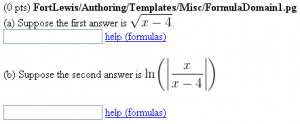Difference between revisions of "FormulaDomain1"
(Created page with '<h2>Answer is a Function with Domain Issues</h2> 300px|thumb|right|Click to enlarge <p style="background-color:#f9f9f9;border:black solid 1px;padding…') |
|||
| Line 140: | Line 140: | ||
<p> |
<p> |
||
<b>Answer Evaluation:</b> |
<b>Answer Evaluation:</b> |
||
| − | It is possible to specify the limits and test points for evaluation in the argument to <code>cmp()</code>. For more details, please see [http://webwork.maa.org/wiki/FormulaTestPoints formula test points] in the index of problem techniques. |
||
| + | It is possible to get diagnostic information about the answer checker using <code>cmp(diagnostics=>1)</code>. |
||
</p> |
</p> |
||
<p> |
<p> |
||
Revision as of 02:20, 6 December 2010
Answer is a Function with Domain Issues
This PG code shows how to set the domain and test points for a formula.
- Download file: File:FormulaDomain1.txt (change the file extension from txt to pg when you save it)
- File location in NPL:
FortLewis/Authoring/Templates/Misc/FormulaDomain1.pg
| PG problem file | Explanation |
|---|---|
|
Problem tagging: |
|
DOCUMENT(); loadMacros( "PGstandard.pl", "MathObjects.pl", "AnswerFormatHelp.pl", "answerHints.pl", ); TEXT(beginproblem()); |
Initialization:
We load |
Context("Numeric");
$a = random(2,5,1);
$answer1 = Compute("sqrt(x-$a)");
$answer1->{limits} = [$a+1,$a+4];
$answer2 = Compute("ln(abs( x / (x-$a) ))");
$answer2->{test_points} = [[-5],[-4],[1],[$a-1],[7],[8]];
|
Setup:
We restrict the domain of function evaluation using
The domain for It is possible to set the domain once for all of the functions within a particular context. For more details, please see formula test points in the index of problem techniques. |
Context()->texStrings;
BEGIN_TEXT
(a) Suppose the first answer is
\( \displaystyle $answer1 \).
$BR
\{ ans_rule(20) \}
\{ AnswerFormatHelp("formulas") \}
$BR
$BR
(b) Suppose the second answer is
\( \displaystyle $answer2 \)
$BR
\{ ans_rule(20) \}
\{ AnswerFormatHelp("formulas") \}
END_TEXT
Context()->normalStrings;
|
Main Text: Notice that in this multipart question we have grouped the text for each part together in a block, put each answer blank on a new line immediately below each block of text, and added extra space between each part. This should make the question easy to read both in HTML and PDF format. |
$showPartialCorrectAnswers = 1;
ANS( $answer1->cmp() );
ANS( $answer2->cmp()
->withPostFilter(AnswerHints(
[Compute("ln(x/(x-$a))"),Compute("ln(x)-ln(x-$a)")] =>
"Don't forget to use absolute value",
))
);
|
Answer Evaluation:
It is possible to get diagnostic information about the answer checker using
For the second answer, we have used |
Context()->texStrings;
BEGIN_SOLUTION
${PAR}SOLUTION:${PAR}
Solution explanation goes here.
END_SOLUTION
Context()->normalStrings;
COMMENT('MathObject version.');
ENDDOCUMENT();
|
Solution: |
